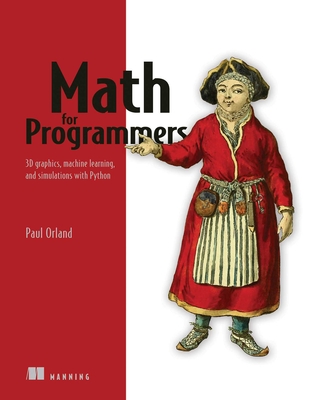Interpretable Machine Learning with Python: Learn to build interpretable high-performance models with hands-on real-world examples (Paperback)
暫譯: 可解釋的機器學習與 Python:學習構建可解釋的高效能模型,並透過實際案例進行實作(平裝本)
Masís, Serg
- 出版商: Packt Publishing
- 出版日期: 2021-03-26
- 定價: $1,850
- 售價: 8.0 折 $1,480
- 語言: 英文
- 頁數: 736
- 裝訂: Quality Paper - also called trade paper
- ISBN: 180020390X
- ISBN-13: 9781800203907
-
相關分類:
Python、程式語言、Machine Learning
-
其他版本:
Interpretable Machine Learning with Python - Second Edition: Build explainable, fair, and robust high-performance models with hands-on, real-world exa
買這商品的人也買了...
-
 電腦網際網路, 6/e (國際版)(Computer Networking: A Top-Down Approach, 6/e)(附部分內容光碟)
電腦網際網路, 6/e (國際版)(Computer Networking: A Top-Down Approach, 6/e)(附部分內容光碟)$650$585 -
 Pro Oracle SQL, 2/e (Paperback)
Pro Oracle SQL, 2/e (Paperback)$2,800$2,660 -
 資料科學的商業運用 (Data science for business)
資料科學的商業運用 (Data science for business)$680$537 -
 $1,098Introduction to Computation and Programming Using Python: With Application to Understanding Data, 2/e (Paperback)
$1,098Introduction to Computation and Programming Using Python: With Application to Understanding Data, 2/e (Paperback) -
 $990Hands-On Machine Learning with Scikit-Learn and TensorFlow (Paperback)
$990Hands-On Machine Learning with Scikit-Learn and TensorFlow (Paperback) -
 Data Mining for Business Analytics: Concepts, Techniques, and Applications in R (Hardcover)
Data Mining for Business Analytics: Concepts, Techniques, and Applications in R (Hardcover)$3,900$3,705 -
 $1,188Deep Reinforcement Learning Hands-On
$1,188Deep Reinforcement Learning Hands-On -
 Hands-On Machine Learning with Scikit-Learn, Keras, and TensorFlow, 2/e (Paperback)
Hands-On Machine Learning with Scikit-Learn, Keras, and TensorFlow, 2/e (Paperback)$2,680$2,546 -
 $393深度學習的數學
$393深度學習的數學 -
 數據挖掘導論, 2/e (Introduction to Data Mining, 2/e)
數據挖掘導論, 2/e (Introduction to Data Mining, 2/e)$834$792 -
 Feature Engineering and Selection: A Practical Approach for Predictive Models (Hardcover)
Feature Engineering and Selection: A Practical Approach for Predictive Models (Hardcover)$3,330$3,164 -
 Foundations of Deep Reinforcement Learning: Theory and Practice in Python (Paperback)
Foundations of Deep Reinforcement Learning: Theory and Practice in Python (Paperback)$1,900$1,805 -
 Deep Reinforcement Learning in Action (Paperback)
Deep Reinforcement Learning in Action (Paperback)$1,758$1,665 -
 Math for Programmers: 3D graphics, machine learning, and simulations with Python (Paperback)
Math for Programmers: 3D graphics, machine learning, and simulations with Python (Paperback)$2,166$2,052 -
 $1,421Fundamentals of Machine Learning for Predictive Data Analytics : Algorithms, Worked Examples, and Case Studies, 2/e (Hardcover)
$1,421Fundamentals of Machine Learning for Predictive Data Analytics : Algorithms, Worked Examples, and Case Studies, 2/e (Hardcover) -
 $1,955Machine Learning Design Patterns: Solutions to Common Challenges in Data Preparation, Model Building, and Mlops (Paperback)
$1,955Machine Learning Design Patterns: Solutions to Common Challenges in Data Preparation, Model Building, and Mlops (Paperback) -
 $1,248Python Machine Learning by Example : Build intelligent systems using Python, TensorFlow 2, PyTorch, and scikit-learn, 3/e (Paperback)
$1,248Python Machine Learning by Example : Build intelligent systems using Python, TensorFlow 2, PyTorch, and scikit-learn, 3/e (Paperback) -
 Deep Learning with Python, 2/e (Paperback)
Deep Learning with Python, 2/e (Paperback)$2,200$2,090 -
 Data-Driven Science and Engineering: Machine Learning, Dynamical Systems, and Control, 2/e (Hardcover)
Data-Driven Science and Engineering: Machine Learning, Dynamical Systems, and Control, 2/e (Hardcover)$2,275$2,161 -
 Generative AI with LangChain: Build large language model (LLM) apps with Python, ChatGPT and other LLMs (Paperback)
Generative AI with LangChain: Build large language model (LLM) apps with Python, ChatGPT and other LLMs (Paperback)$1,980$1,881
商品描述
Understand the key aspects and challenges of machine learning interpretability, learn how to overcome them with interpretation methods, and leverage them to build fairer, safer, and more reliable models
Key Features:
- Learn how to extract easy-to-understand insights from any machine learning model
- Become well-versed with interpretability techniques to build fairer, safer, and more reliable models
- Mitigate risks in AI systems before they have broader implications by learning how to debug black-box models
Book Description:
Do you want to understand your models and mitigate risks associated with poor predictions using machine learning (ML) interpretation? Interpretable Machine Learning with Python can help you work effectively with ML models.
The first section of the book is a beginner's guide to interpretability, covering its relevance in business and exploring its key aspects and challenges. You'll focus on how white-box models work, compare them to black-box and glass-box models, and examine their trade-off. The second section will get you up to speed with a vast array of interpretation methods, also known as Explainable AI (XAI) methods, and how to apply them to different use cases, be it for classification or regression, for tabular, time-series, image or text. In addition to the step-by-step code, the book also helps the reader to interpret model outcomes using examples. In the third section, you'll get hands-on with tuning models and training data for interpretability by reducing complexity, mitigating bias, placing guardrails, and enhancing reliability. The methods you'll explore here range from state-of-the-art feature selection and dataset debiasing methods to monotonic constraints and adversarial retraining.
By the end of this book, you'll be able to understand ML models better and enhance them through interpretability tuning.
What You Will Learn:
- Recognize the importance of interpretability in business
- Study models that are intrinsically interpretable such as linear models, decision trees, and Na ve Bayes
- Become well-versed in interpreting models with model-agnostic methods
- Visualize how an image classifier works and what it learns
- Understand how to mitigate the influence of bias in datasets
- Discover how to make models more reliable with adversarial robustness
- Use monotonic constraints to make fairer and safer models
Who this book is for:
This book is for data scientists, machine learning developers, and data stewards who have an increasingly critical responsibility to explain how the AI systems they develop work, their impact on decision making, and how they identify and manage bias. Working knowledge of machine learning and the Python programming language is expected.
商品描述(中文翻譯)
了解機器學習可解釋性的關鍵方面和挑戰,學習如何通過解釋方法克服這些挑戰,並利用它們構建更公平、更安全和更可靠的模型
主要特點:
- 學習如何從任何機器學習模型中提取易於理解的見解
- 熟悉可解釋性技術,以構建更公平、更安全和更可靠的模型
- 通過學習如何調試黑箱模型,在其產生更廣泛影響之前減輕人工智慧系統的風險
書籍描述:
您是否想了解您的模型並減輕與不良預測相關的風險,使用機器學習(ML)解釋?《使用 Python 的可解釋機器學習》可以幫助您有效地處理 ML 模型。
本書的第一部分是可解釋性的初學者指南,涵蓋其在商業中的相關性,並探討其關鍵方面和挑戰。您將專注於白箱模型的運作方式,將其與黑箱和玻璃箱模型進行比較,並檢查它們之間的權衡。第二部分將使您熟悉各種解釋方法,也稱為可解釋人工智慧(XAI)方法,以及如何將它們應用於不同的用例,無論是分類還是回歸,對於表格數據、時間序列、圖像或文本。除了逐步的代碼示例外,本書還幫助讀者通過示例解釋模型結果。在第三部分,您將親自調整模型和訓練數據以提高可解釋性,通過降低複雜性、減輕偏見、設置防護措施和增強可靠性來實現。您將在這裡探索的技術範圍從最先進的特徵選擇和數據集去偏見方法到單調約束和對抗性再訓練。
在本書結束時,您將能夠更好地理解 ML 模型並通過可解釋性調整來增強它們。
您將學到的內容:
- 認識可解釋性在商業中的重要性
- 研究本質上可解釋的模型,如線性模型、決策樹和朴素貝葉斯
- 熟悉使用模型無關方法解釋模型
- 可視化圖像分類器的運作方式及其學習內容
- 了解如何減輕數據集中的偏見影響
- 發現如何通過對抗性穩健性使模型更可靠
- 使用單調約束來構建更公平和更安全的模型
本書適合誰:
本書適合數據科學家、機器學習開發人員和數據管理者,他們在解釋所開發的人工智慧系統的運作、對決策的影響以及如何識別和管理偏見方面承擔越來越重要的責任。預期具備機器學習和 Python 程式語言的工作知識。


















